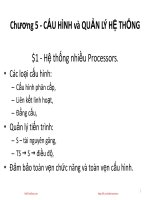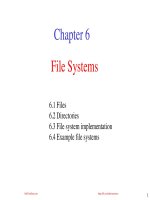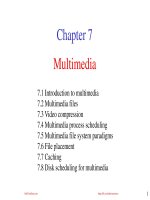hệ điều hành nguyễn văn hiệp chương ter 04 memory management sinhvienzone com
Bạn đang xem bản rút gọn của tài liệu. Xem và tải ngay bản đầy đủ của tài liệu tại đây (4.9 MB, 63 trang )
Chapter 4
Memory Management
4.1 Basic memory management
4.2 Swapping
4.3 Virtual memory
4.4 Page replacement algorithms
4.5 Modeling page replacement algorithms
4.6 Design issues for paging systems
4.7 Implementation issues
4.8 Segmentation
SinhVienZone.com
/>
1
Memory Management
• Ideally programmers want memory that is
– large
– fast
– non volatile
• Memory hierarchy
– small amount of fast, expensive memory – cache
– some medium-speed, medium price main memory
– gigabytes of slow, cheap disk storage
• Memory manager handles the memory hierarchy
SinhVienZone.com
/>
2
Basic Memory Management
Monoprogramming without Swapping or Paging
Three simple ways of organizing memory
- an operating system with one user process
SinhVienZone.com
/>
3
Multiprogramming with Fixed Partitions
• Fixed memory partitions
– separate input queues for each partition
– single input queue
SinhVienZone.com
/>
4
Modeling Multiprogramming
Degree of multiprogramming
CPU utilization as a function of number of processes in memory
SinhVienZone.com
/>
5
Analysis of Multiprogramming System
Performance
• Arrival and work requirements of 4 jobs
• CPU utilization for 1 – 4 jobs with 80% I/O wait
• Sequence of events as jobs arrive and finish
–note numbers show amout of CPU time jobs get in each interval
SinhVienZone.com
/>
6
Relocation and Protection
• Cannot be sure where program will be loaded in memory
– address locations of variables, code routines cannot be absolute
– must keep a program out of other processes’ partitions
• Use base and limit values
– address locations added to base value to map to physical addr
– address locations larger than limit value is an error
SinhVienZone.com
/>
7
Swapping (1)
Memory allocation changes as
– processes come into memory
– leave memory
Shaded regions are unused memory
SinhVienZone.com
/>
8
Swapping (2)
• Allocating space for growing data segment
• Allocating space for growing stack & data segment
SinhVienZone.com
/>
9
Memory Management with Bit Maps
• Part of memory with 5 processes, 3 holes
– tick marks show allocation units
– shaded regions are free
• Corresponding bit map
• Same information as a list
SinhVienZone.com
/>
10
Memory Management with Linked Lists
Four neighbor combinations for the terminating process X
SinhVienZone.com
/>
11
Virtual Memory
Paging (1)
The position and function of the MMU
SinhVienZone.com
/>
12
Paging (2)
The relation between
virtual addresses
and physical
memory addresses given by
page table
SinhVienZone.com
/>
13
Page Tables (1)
Internal operation of MMU with 16 4 KB pages
SinhVienZone.com
/>
14
Page Tables (2)
Second-level page tables
Top-level
page table
• 32 bit address with 2 page table fields
• Two-level page tables
SinhVienZone.com
/>
15
Page Tables (3)
Typical page table entry
SinhVienZone.com
/>
16
TLBs – Translation Lookaside Buffers
A TLB to speed up paging
SinhVienZone.com
/>
17
Inverted Page Tables
Comparison of a traditional page table with an inverted page table
SinhVienZone.com
/>
18
Page Replacement Algorithms
• Page fault forces choice
– which page must be removed
– make room for incoming page
• Modified page must first be saved
– unmodified just overwritten
• Better not to choose an often used page
– will probably need to be brought back in soon
SinhVienZone.com
/>
19
Optimal Page Replacement Algorithm
• Replace page needed at the farthest point in future
– Optimal but unrealizable
• Estimate by …
– logging page use on previous runs of process
– although this is impractical
SinhVienZone.com
/>
20
Not Recently Used Page Replacement Algorithm
• Each page has Reference bit, Modified bit
– bits are set when page is referenced, modified
• Pages are classified
1.
2.
3.
4.
not referenced, not modified
not referenced, modified
referenced, not modified
referenced, modified
• NRU removes page at random
– from lowest numbered non empty class
SinhVienZone.com
/>
21
FIFO Page Replacement Algorithm
• Maintain a linked list of all pages
– in order they came into memory
• Page at beginning of list replaced
• Disadvantage
– page in memory the longest may be often used
SinhVienZone.com
/>
22
Second Chance Page Replacement Algorithm
• Operation of a second chance
– pages sorted in FIFO order
– Page list if fault occurs at time 20, A has R bit set
(numbers above pages are loading times)
SinhVienZone.com
/>
23
The Clock Page Replacement Algorithm
SinhVienZone.com
/>
24
Least Recently Used (LRU)
• Assume pages used recently will used again soon
– throw out page that has been unused for longest time
• Must keep a linked list of pages
– most recently used at front, least at rear
– update this list every memory reference !!
• Alternatively keep counter in each page table entry
– choose page with lowest value counter
– periodically zero the counter
SinhVienZone.com
/>
25









